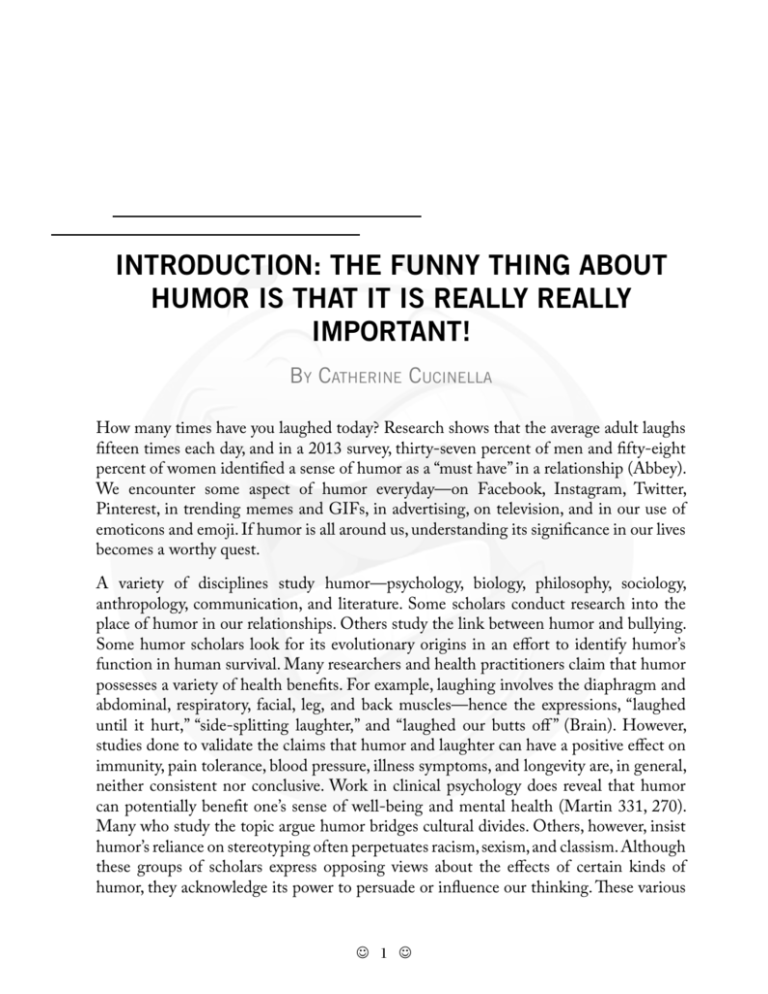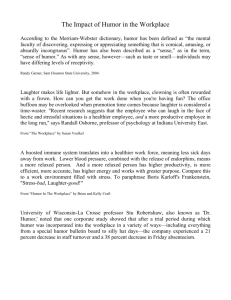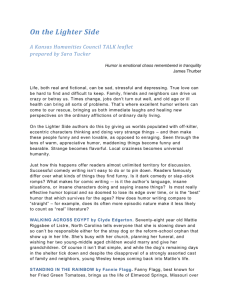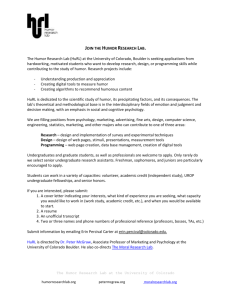
INTRODUCTION: THE FUNNY THING ABOUT
HUMOR IS THAT IT IS REALLY REALLY
IMPORTANT!
By Catherine Cucinella
How many times have you laughed today? Research shows that the average adult laughs
fifteen times each day, and in a 2013 survey, thirty-seven percent of men and fifty-eight
percent of women identified a sense of humor as a “must have” in a relationship (Abbey).
We encounter some aspect of humor everyday—on Facebook, Instagram, Twitter,
Pinterest, in trending memes and GIFs, in advertising, on television, and in our use of
emoticons and emoji. If humor is all around us, understanding its significance in our lives
becomes a worthy quest.
A variety of disciplines study humor—psychology, biology, philosophy, sociology,
anthropology, communication, and literature. Some scholars conduct research into the
place of humor in our relationships. Others study the link between humor and bullying.
Some humor scholars look for its evolutionary origins in an effort to identify humor’s
function in human survival. Many researchers and health practitioners claim that humor
possesses a variety of health benefits. For example, laughing involves the diaphragm and
abdominal, respiratory, facial, leg, and back muscles—hence the expressions, “laughed
until it hurt,” “side-splitting laughter,” and “laughed our butts off ” (Brain). However,
studies done to validate the claims that humor and laughter can have a positive effect on
immunity, pain tolerance, blood pressure, illness symptoms, and longevity are, in general,
neither consistent nor conclusive. Work in clinical psychology does reveal that humor
can potentially benefit one’s sense of well-being and mental health (Martin 331, 270).
Many who study the topic argue humor bridges cultural divides. Others, however, insist
humor’s reliance on stereotyping often perpetuates racism, sexism, and classism. Although
these groups of scholars express opposing views about the effects of certain kinds of
humor, they acknowledge its power to persuade or influence our thinking. These various
1
Funny
disciplines and scholars employ different approaches and often stress the different aspects
and effects of humor; however, they all assume that humor involves a degree of creativity
and the capacity for conceptual understanding and conceptual shifts. Furthermore, many
scholars argue that humor is a uniquely human characteristic. As you can see, humor is a
relevant topic of study because of its significant role in the following three areas: identity
(ontology), culture, and knowledge or meaning-making (epistemology).
What do I mean when I say that humor, or what we find funny, is connected to who we
are, to our culture or society, and to what or how we know things? First, I proceed on
the assumption that most of us agree that identity, culture, and knowledge are connected
(at least, on some level, the culture and society in which we live, and the stuff we know,
and how we make sense of things does influence our sense of self ). Second, on the most
basic level, I mean that what we find funny and how we use humor reflect and shape our
identity. Third, because it generates from and means something within specific cultures
and societies, humor reveals what a culture or society values. What a twenty-somethingyear-old Chinese American female living in San Jose, California finds funny might
not tickle the funny bone of a twenty-something-year-old female living in Bangalore,
India. In addition to this larger cultural aspect, our more immediate social environments
influence what we find funny, and humor often serves a social purpose. We use humor
to connect with people or to ridicule and exclude individuals, to smooth over awkward
moments, or to diffuse a volatile situation. Fourth, because using and getting humor
very often rely on stereotypes and on our prior knowledge, humor often influences our
perspectives on people different from us and on political and social issues. In other words,
what we laugh at can construct our knowledge of our world.
The articles, stories, studies, blogs, satires, and reports that comprise Funny complicate
rather than simplify what humor is, how it works, and its place in our lives. These readings
invite you to examine humor and laughter through diverse lenses and to think critically
about the value, politics, and ethics of humor. As you read and write about this topic,
you will necessarily have to grapple with issues of race, sexuality, class, exclusion, and
inclusion, and perhaps religion, politics, free speech, nationalism, and health—all of
which tie to identity, culture, and knowledge. Thus, becoming aware of the many aspects
of humor opens exciting and provocative pathways of critical inquiry.
HUMOR, CULTURE, AND THE INTERNET
Today humor proliferates as the Internet has become the medium, par excellence, for
creating and disseminating humor, as well as changing the cultural landscape of humor.
The Internet meme phenomenon is only one example of social media’s influence on what
we deem funny. Although not a required characteristic, humor is often present in memes.
A meme can suggest an “inside joke,” and once the meme “goes viral,” the circle of insiders
who get the joke enlarges, thus expanding what individuals consider funny. Because
2
Introduction: The Funny Thing about
Humor Is that it Is Really Really Important!
cultural ideas and cultural humor are important characteristics of memes, they transmit
both, a transmission that can potentially enhance cross-cultural understandings. In other
words, the Internet adds a global dimension to humor. This global aspect results from the
Internet’s ability to make visual the local by particularizing jokes, humorous events, and
experiences. YouTube, which makes available a glimpse at specific cultural and topical
humor to millions of people around the world, exemplifies the globalization of the local.
For example, rappers Nice Peter and EpicLLOYD, creators of Epic Rap Battles of History,
each assume different characters spitting rap lines at each other. When Epic Rap Battles
pits Elvis Presley against Michael Jackson, or Albert Einstein against Stephen Hawking,
or Gandalf against Dumbledore, or Santa Claus against Moses, it relies upon specific
cultural knowledges and experiences. However, because these rap battles also feature
physical humor, one can lack this cultural knowledge and still enjoy the humor. In other
words, these raps can evoke laughter from those of us who may not fully get the humor,
especially if we enjoy slapstick. This enjoyment explains the popularity and ubiquity of
the “Epic Fails,” “Scary Snowman,” and pranking videos on the web.
Copyright © 2014 Art Streiber.
The Internet has helped to translate
humor across cultural lines, nevertheless
specific social and cultural dimensions
greatly influence what we do or do not
find funny. For example, Cultural Savvy,
a program to help global businesses
develop cultural competency, provides
“some basic rules to remember” regarding
humor: “Each culture has its own style
of humor.” “Humor is very difficult to
export.” “Humor requires an in-depth
understanding of culture.” “Avoid
the following: ethnic-type humor,
stereotyping, sexist, off-color, cultural, or
religious humor” (“Using Humor”).These
“rules” clearly indicate the importance of
understanding the link between humor
and culture. However, as you know we
can share laughter with people different
from us; we may not always agree on why
something is funny, but we all agree that
humor is important in our lives and in
our world.
Kevin Hart “says he has internalized something Chris
Rock once told him: the only thing all people have in
common, regardless of race, gender, faith, politics or
sexual preference, is that they like to laugh” (Wallace).
3
Funny
HUMOR, LAUGHTER, AND HUMANNESS
As you study humor—read and write about it—you will do more than amass information
about a subject because humor, according to philosopher Simon Critchley, tells us about
being human. Whether tongue-in-cheek or not, Critchley writes that humor makes us
human because Aristotle tells us so. His reference to Aristotle reminds us that humor
and questions of being (ontological questions) have long fascinated philosophers. Most
humor scholars agree with philosopher and humor theorist, John Morreall, author of
Taking Laughter Seriously, that “our capacity to laugh is anything but a peripheral aspect
of human life and to understand our laughter is to go a long way toward understanding
our humanity” (x). However, philosophers are not the only scholars who make this claim
about the ontological aspects of humor. Identifying their approach as that of theoretical
cognitive scientists, Matthew Hurley, cognitive scientist; Daniel Dennett, philosopher;
and Reginald Adams, psychologist point out that the jokes we tell and the situations,
things, and people at which we choose to laugh reveal to others where we position
ourselves in the world (12). In our laughter and through our sense of humor, we may
reveal our humanity or perhaps, at times, our inhumanity.
The paradox of humor is that we need the mental dexterity to get and express it, but
humor’s manifestation and expression almost always involve the physical body, which
as some argue, becomes very “animal-like” in certain forms of humor. Take a moment
to think about the language we use to describe our laughter: cackle, howl, shriek, roar,
bray, snort, hee-haw, crow—all very animal-like, indeed! You might wonder if animals
laugh, and if they do, whether their laughter means they “get the joke.” The abundance
of images of laughing animals on the Internet seems to provide ample evidence of both.
Do laughing animals make them more human, or do they disprove humor’s link to
humanness? Neurologist and neuropsychiatrist, Richard Restak tells us that although
studies of apes suggest they engage in teasing “accompanied by laughter,” apes cannot
“make multiple interpretations of a situation” (22). In other words, they may laugh, but
they are reacting to the play rather than to a conceptual understanding or appreciation
of humor.
Getting humor involves the networks in the brain, networks located in the cerebral
cortex “related to speech, general information, and the appreciation of contradiction and
illogicality” (Restak 21). For humans, humor very much relies on one or more of these
areas. In order to find something funny, we draw on what we know, believe, and expect.
We depend on generalized scripts and unrecognized (and unexamined) assumptions on
which these scripts rest. Our ability to make sense of an inconsistency between a script
and a humorous situation and to appreciate the humor in the contradiction and illogicality
is a mark of our humanness (22).
Restak also points to the distinction between laughter and humor. We can laugh even in the
absence of humor, pointing out we may laugh when we are frightened, sad, or embarrassed.
4
Introduction: The Funny Thing about
Humor Is that it Is Really Really Important!
Many humor scholars note that a difference exists between humor and laughter, yet, as
you will discover, it often becomes impossible to address one without addressing the
other. Marshall Brain,
founder of HowStuffWorks,
states, in “How Laughter
Works,” “Laughter is the
physiological
response
to humor.” Your first
reaction might be that
Brain is making an obvious
distinction. However, as
you explore this topic more
fully through the readings,
assignments, and activities
in Funny, you may want
to revisit this assumption.
Perhaps untangling the
physiological—or at least
the
corporeal—from
humor is not quite as
straightforward as it seems.
Indeed, as noted above,
Morreall argues for the Sharing a laugh or sharing a joke?
centrality of laughter in
human life. In light of Restak’s study, we might conclude that regardless of how animallike our expression of humor or how human-like animal laughter seems the ability to
interpret the joke, humorous event, or experience is a uniquely human characteristic. In
addition, we might further conclude that humor’s cultural, ontological, and epistemological
aspects solidify its link to our humanness. This book encourages you to investigate these
arguments and conclusions and to figure out where you stand in relation to the various
theories regarding humor’s place in our world.
THREE THEORIES OF HUMOR AND HOW HUMOR FUNCTIONS
Many of the readings in Funny draw from, rely on, or expand upon well-developed
theories of humor. The following theories constitute the foundational explanations of
humor—of what we find funny and why we laugh: the incongruity, the superiority, and
the relief theories. The incongruity theory of humor aligns with the cognitive aspect of
humor and laughter. This theory posits humor as an intellectual response to something
that surprises us—to something that differs from the norm or accepted pattern. We
laugh at situations, actions, or behaviors we find illogical, unexpected, or inappropriate.
However, our ability to “resolve” the incongruity proves crucial for us to appreciate the
5
Funny
humor. The superiority theory of humor is, as its name implies, based on the notion that
we laugh because we feel superior to other people. Laughter then becomes an expression
of this feeling of superiority. This theory is used to ridicule, bully, exclude, as well as to
strengthen group solidarity or as a social corrective. In its simplest form, the relief theory
of humor ties to the biological function of laughter and expresses a physiological point of
view. Humor and laughter release tension or excessive energy. Of course, the incongruity,
superiority, and relief theories of humor are more complex than I present them here,
and they necessarily overlap in many ways. Each offers slightly different explanatory
approaches to the subject. The incongruity theory tells us why we find something funny;
the relief theory stresses humor’s function. The superiority theory seems to do both and
also reveals the personal and social dimensions of humor.
Although our sense of humor may be individual and tied to a specific cultural context,
humor and laughter are social. Many who study both argue that, in addition to having
a social aspect, humor and laughter also serve a social function. In other words, humor
is important not only for the health and well-being of the individual but also for that
of a community, society, and culture. Morreall devotes an entire chapter of his book on
laughter to “the social value of humor.” He sees laughter as contagious; it possesses a
“cohesive effect” and is “a friendly social gesture”; “it facilitates social interaction” (11420). Morreall’s view of laughter should resonate with all of us. At some point in our
lives, we have “caught laughter,” laughed because someone else was laughing. Although
the Internet and increased opportunities afforded to us by social media (check out
Dave Barry’s “Technology” on this subject, page 219 in Funny) means that we often are
physically alone when we encounter humor, one might argue that we are in a virtual social
context. In other words, we have a sense of a communal or shared experience of humor
just as we do when we watch TV.
Rod Martin, like Morreall, addresses the social context of humor, noting that “[h]umor
can (and frequently does) occur in virtually any social situation” and identifies “the social
context of humor [as] one of play” (5). This play, however, can often be very serious,
and humor often becomes an effective mode through which to challenge the status
quo, confront narrow-mindedness, or enact social protest. The use of humor to address
inequality, oppression, and the abuse of power has a long history. While my purpose in
Funny is not to present this history, I hope that as you encounter the various perspectives
on humor and laugh at (or not) the stories and images in this text you will want to
learn more about the historical roots of humor. Knowing that humor draws upon a rich
tradition enhances our understanding of its potential to change perceptions and practices.
HUMOR’S PERSUASIVE POWER
When we examine the ways individuals unconsciously and consciously employ humor, we
find that used skillfully and purposefully it is an effective persuasive strategy or rhetorical
6
Introduction: The Funny Thing about
Humor Is that it Is Really Really Important!
tool. This idea—humor’s link to rhetoric—is not a new one. Plato, when he conceived
of his perfect society, had strong views on laughter, marginalizing those at whom
laughter is directed and condemning what he perceived as the inherently derogatory
nature of humor. His concern with humor and laughter, however, indicates that Plato
saw humor’s potential to influence how individuals think and act. Indeed, the Roman
orators/rhetoricians Cicero and Quintilian (whose ideas still influence our understanding
and practice of rhetoric) acknowledge humor’s appropriateness in specific rhetorical
situations, and both point out that humor may relieve or diffuse tensions thus benefitting
the speaker and his argument (yes, they meant males).
In On Oratory and Orators, Cicero provides instructions for invention in oratory,
specifically noting that “[a] jocose manner, too, and strokes of wit, give pleasure to an
audience, and are often of great advantage to the speaker” (II.LIV 144). Used carefully and
artfully, humor strengthens the speaker’s position and enhances his ethos (II.LVII 150).
Quintilian, like Cicero, instructed orators of his day on the proper and effective techniques
of oration, and, like Cicero, he finds value in the strategic use of humor. Specifically, in his
textbook on the theory and practice of rhetoric, Institutes of Oratory, Quintilian, locates
great power in laughter because it “very frequently dissipates both hatred and anger” (VI.
III). He is quite clear, however, that the ability to use humor effectively—to the orator’s
advantage—is rare. Nonetheless, Quintilian spends a considerable amount of time in
Book VI providing examples of and explaining humor’s rhetorical fitness. In other words,
he includes humor as an effective means of swaying an orator’s audience and opponents,
of gaining an advantage, and of changing perspectives.
Satire may best exemplify the persuasiveness and the promise of humor. Satire, often
humorous, critiques human vice and folly in an attempt to improve human institutions
or humanity and relies on comedic devices such as parody and exaggeration. Satirists see
great power in humor, and in their hands, humor becomes the mirror that reflects our
flaws. However, rather than using it as a weapon to destroy humanity, satirists use humor
as a tool to expose and dismantle these flaws—to offer social commentary and change
perspectives. Television shows like Saturday Night Live, South Park, The Simpsons, Family
Guy, The Daily Show with Jon Stewart, The Colbert Report, and Parks and Recreation offer
satirical commentary on a wide range of topics. However, first and foremost, these shows
make us laugh.
ETHNIC-RACIAL HUMOR
As today’s comedians make us laugh, they also make us think. Much like Shakespeare’s
fools and clowns who often possess the clearest vision of their fellow human beings and
their society, our comedians often force us to see ourselves and others more clearly and
to listen more keenly to voices other than our own. Comedians like Richard Pryor, Dave
Chappelle, Margaret Cho, Louis CK, and Gabriel Iglesias open a space for us to talk
7
Funny
about difficult issues such as racism, sexism, and classism. Although one can use humor
to reinforce those “isms,” these funny men and women use humor to confront harmful
stereotypes and to reveal unexamined assumptions about blacks, Asians, Mexicans,
lesbians, gays, and working class Americans. These “isms,” stereotypes, and assumptions
seem tightly linked to our sense of self and to important social and cultural issues.
Therefore, examining the relationship between humor and race is not always easy. How
often have you laughed at a joke that you considered racist? Have you ever stopped
someone from telling a racist joke? How does one use humor to challenge racism?
Almost universally, ethnic and racial humor works on the model whereby jokes target
marginalized groups. In this form of disparaging humor, according to David Gillota,
author of Ethnic Humor in Multiethnic America, “Very often, the dominant group remains
unseen or simply implied” (10). This invisibility extends into the opposing sets of
adjectives that drive disparaging jokes (smart/stupid, industrious/lazy), with the positive
value (smart, industrious) implicitly aligning with the perceived characteristics of the
dominant group (Rappoport 133). Because stereotypes and slurs are staples of ethnic
and racial humor, they become important areas to consider. If we look at the history of
American ethnic humor, we see, from colonial times until about the 1950s, this humor
included “ethnic caricatures in newspapers cartoons . . . in minstrel shows . . . [which]
survive[ed] throughout much of the twentieth century” (Gillota 7). By the civil rights
movement, ethnic comedians such as African Americans Dick Gregory and Richard
Pryor and those of Jewish heritage such as Lenny Bruce, Woody Allen, and Mel Brooks
emerged. Although Gillota asserts that “these humorists would rework familiar ethnic
stereotypes, often collapsing or subverting them,” I urge you to consider how one knows
if the humor reinforces or challenges the stereotype (8). Nevertheless, when the difficult
becomes funny, the potential for change, or empathy, or understanding does emerge.
BAWDY HUMOR—CHALLENGING TABOOS
However, this notion of “funny” gets stickier when we turn our attention to taste or
bawdiness. In his 2013 piece on the backlash caused by Seth MacFarlane’s performance
as host of that year’s Academy Awards, Chicago Tribune’s chief theater critic, Chris Jones,
addresses the subject of offensive humor. Referring specifically to Jon Stewart and The
Onion (a satirical online newspaper), Jones writes “that even top brand names in comedy
are struggling to figure what’s actually offensive these days.” Like other aspects of humor
and laughter that you will read about in Funny, questions about humor’s bawdiness have
a long history. Contemporary comedy and comedic performances of scatological (vulgar,
crude, off-color) humor flow from the tradition of the Greek dramatist Aristophanes
(c 44-380 B.C.), whose plays abound with implicit and explicit sexual humor tightly
wedded to his brilliant political satire. We find further examples of ribald humor in
Geoffrey Chaucer’s The Canterbury Tales (1475), specifically in “The Millar’s Tale,” a
fabliau, a story showing high class people in comical or satirical compromising situations
8
Introduction: The Funny Thing about
Humor Is that it Is Really Really Important!
involving sex and/or money. The “tradition” of bawdiness continues in the work of William
Shakespeare (1564-1616). Almost all of his plays (the tragedies and comedies), contain
sexual puns, double entendres, and characters engaged in sexual banter. Shakespeare, like
Aristophanes and Chaucer, understood and evoked scatological humor because it makes
us laugh, maybe because of or despite its “crudeness.” However, many argue humor and
laughter remind us that we are human, in a bodily (bawdy) sense.
WHAT FUNNY WANTS YOU
TO DO
Funny embraces this messiness
as it asks you to read, write, and
think critically about the following
9
Copyright © 1987 Bill Waterson and Universal Press Syndicate. All Rights Reserved.
The current debates regarding off-color or vulgar humor are not new. When the civil
rights movement provided a “stage” for ethnic comedians to talk about racial issues,
these same comedians, most notably Redd Foxx, Lenny Bruce, and Richard Pryor, also
incorporated raunch humor into their performances. However, these comedians’ bawdy
humor sounded and looked very different from that of Aristophanes, Chaucer, and
Shakespeare. Foxx, Bruce, and Pryor each deliberately violated taboos by giving public
voice to private lived-experiences of marginalized peoples. Using X-rated language, Foxx
spoke what he heard and knew about being a black man in white America. Pryor, too,
drew on his own experiences as a black man in America and “defied the boundaries of
taste, decency and race to become the comic voice of a generation” (Schudel). Intent on
challenging the status quo, everything deemed socially acceptable, and the limits of free
speech, Bruce may be the “poster
boy” of scatological humor. This
iconoclast of the 1950-60s, brought
up on obscenity charges for his
night club comedy, defended the
comic’s right to free speech. Today,
humor’s bawdiness seems routine in
comedy clubs, television programs,
films, and other media. However, as
comedians, humorists, and satirists
use humor to challenge taboos or
find new ways to make us laugh,
controversies regarding the limits of
acceptability and taste will continue.
Humor—what it is, how we use it,
what it means, and how we interpret
it—is messy.
Funny
questions: When and why is something funny or not? Who decides what is funny? Can
humor transcend cultures? How do race, class, and gender affect our sense of humor?
Does humor promote inclusion or exclusion? What can we learn about ourselves, about
others, about our world by examining what we find funny and what other people find
funny? Is humor ever innocent? Finally, I hope that Funny opens up a multitude of other
areas for you to explore and that the selections get you thinking and, yes, laughing.
Copyright © 2013 Mike Luckovich. All Rights Reserved.
Works Cited
Abbey, Jennifer. “Top Qualities Single Men and Women Seek in the Opposite Sex.” ABCNews.
Go.com. ABC News. 05 Feb. 2013. Web. 08 July 2014.
Brain, Marshall. “How Laughter Works.” HowStuffWorks. Web. 12 Dec. 2012.
Cicero. On Oratory and Orators. Trans. Ralph A. Micken. Carbondale: Southern Illinois UP,
1970. Print.
10
Introduction: The Funny Thing about
Humor Is that it Is Really Really Important!
Critchley, Simon. On Humor. New York: Routledge, 2002. Print.
Gillota, David. Ethnic Humor in Multiethnic America. New Brunswick: Rutgers University Press,
2013. Print.
Hurley, Matthew, Daniel Dennett, and Reginald Adams Jr. Inside Jokes: Using Humor to ReverseEngineer the Mind. Cambridge: MIT Press, 2011. Print.
Jones, Chris. “When Jokes Go Too Far.” ChicagoTribune.com The Chicago Tribune. 01 Mar.
2013. Web. 13 Jan. 2014.
Lefcourt, Herbert M. Humor: The Psychology of Living Buoyantly. New York: Kluwer Academic/
Plenum Publishers, 2001. Print.
Martin, Rod. The Psychology of Humor: An Integrative Approach. Burlington, MA: Elsevier, 2007.
Print.
Morreall, John. Taking Laughter Seriously. Albany: State University of New York, 1983. Print.
Quintilian. Institutes of Oratory. Ed. Lee Honeycutt. Trans. John Selby Watson. 2006. Iowa State.
Web. 10 Mar. 2014. <http://rhetoric.eserver.org/quintilian/>.
Rappoport, Leon. Punchlines: The Case for Racial, Ethnic, and Gender Humor. Westport, CT:
Praeger, 2005. Print.
Restak, Richard. “Laughter and the Brain.” The American Scholar 82 (2011): 18-27. Academic
Search Premier. Web. 2 Feb. 2014.
Schudel, Matt. “With Humor and Anger on Race Issues, Comic Inspired a Generation.”
WashingtonPost.com. The Washington Post. 11 Dec. 2005. Web. 18 May 2014.
“Using Humor.” Cultural Savvy, n.d. Web. 07 July 2014.
Wallace, Amy. “Walking Tall with Kevin Hart.” GQ.com. GQ May 2014. Web. 16 July 2014.
11







